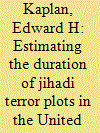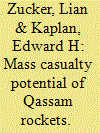|
|
|
Sort Order |
|
|
|
Items / Page
|
|
|
|
|
|
|
| Srl | Item |
| 1 |
ID:
094736


|
|
|
|
|
| Publication |
2010.
|
| Summary/Abstract |
The authors model a terrorist organization's choice over the scale and planning horizon of terror attacks and the consequences for the organization's evolution. The organization can engage in short-term attacks planned and executed in a single period, characterized by a low fixed cost and relatively high marginal cost, and longer term attacks planned and executed over two periods, having a high fixed cost but relatively low marginal cost. Longer term attacks require more resources and cause more damage if successful. Successful attacks increase the organization's size; in addition, the organization has a natural growth rate. Attacks can fail because of failed execution or counterterror interdiction. In a two-period version of this model, the authors analyze the terror organization's attack decisions. They use simulations to characterize optimal strategies and explore their implications for the growth of the organization. The authors identify a set of strategic regimes, and the results show that they always occur in a fixed order as a function of the organization's initial strength.
|
|
|
|
|
|
|
|
|
|
|
|
|
|
|
|
| 2 |
ID:
072554


|
|
|
|
|
| Publication |
2006.
|
| Summary/Abstract |
In the discourse surrounding the Israeli-Palestinian conflict, extreme criticisms of Israel (e.g., Israel is an apartheidstate,theIsraelDefenseForcesdeliberatelytargetPalestiniancivilians),coupled with extreme policy proposals (e.g., boycott of Israeli academics and institutions, divest from companies doing business with Israel), have sparked counterclaims that such criticisms are anti-Semitic (for only Israel is singled out). The research in this article shines a different, statistical light on this question: based on a survey of 500 citizens in each of 10 European countries, the authors ask whether those individuals with extreme anti-Israel views are more likely to be anti-Semitic. Even after controlling for numerous potentially confounding factors, they find that anti-Israel sentiment consistently predicts the probability that an individual is anti-Semitic, with the likelihood of measured anti-Semitism increasing with the extent of anti-Israel sentiment observed.
|
|
|
|
|
|
|
|
|
|
|
|
|
|
|
|
| 3 |
ID:
116220


|
|
|
|
|
| Publication |
2012.
|
| Summary/Abstract |
The number of ongoing terror plots increases with the duration of time from plot initiation until plot execution or interdiction (whichever comes first), yet no estimate of the probability distribution governing terror plot duration has appeared in the open literature. To remedy this gap, jihadi terror plots in the United States were identified from terrorism-related indictments that occurred between 11 September 2001 and 30 June 2011 in addition to successful attacks. From a review of indictments, affidavits, and other publicly available information, it was possible to identify lower and upper bounds for the initiation date of the plot in question as well as the ending date corresponding to either the arrest of the suspect(s) eventually convicted or an attempted/actual act of terror. These observations enable estimation of the duration distribution of jihadi terror plots in the United States accounting for the censoring and truncation effects inherent with these data (technical details appear in the Appendix). The estimated mean plot duration equals 270 days (standard error of mean 40 days), while 95 percent of all plots are estimated to fall between 33 and 750 days. These estimates suggest that on average, approximately three ongoing terror plots have been active in the United States at any point since 11 September 2001.
|
|
|
|
|
|
|
|
|
|
|
|
|
|
|
|
| 4 |
ID:
132209


|
|
|
|
|
| Publication |
2014.
|
| Summary/Abstract |
In spite of the bombardment of southern Israel by thousands of Qassam rockets fired from the Gaza Strip, comparatively few people have been injured or killed. This has led some observers to dismiss Qassams as more of a symbolic than lethal threat. However, southern Israeli towns feature robust civil defense systems that include safe rooms, bomb shelters, early detection alarms, and missile defense. How many casualties would occur were such systems not in place? This article applies shrapnel-casualty and spatial allocation models to the population of the southern Israeli town of Sderot to estimate casualties per randomly aimed rocket fired into the unprepared town; that is, in the absence of civil defense (technical details appear in the Appendix). Assuming an injury radius of only 5 meters from impact, the modeled expected casualties per rocket are between three (best-case) and nine (worst-case) times higher than Sderot's observed casualties-to-rocket ratio, suggesting that Qassam-like terror attacks on unprotected urban locations could prove much more serious than what one would expect based solely on the observed number of casualties in Sderot.
|
|
|
|
|
|
|
|
|
|
|
|
|
|
|
|
| 5 |
ID:
079527


|
|
|
|
|
| Publication |
2007.
|
| Summary/Abstract |
This article develops sequential game models for key operational terrorist (how often to attack) and government (how often to execute targeted killings) decisions taken during a (counter-) terror campaign such as the second intifada. Key results include the following: The government initiates targeted killings when the marginal number of Israeli civilian lives saved from prevented terror attacks exceeds the marginal number of Palestinian civilian lives lost in such ``hits''; targeted killings are not employed if they are either ineffective or extremely effective at thwarting terror (since terrorists will not induce their use); even after accounting for downstream terror attacks motivated by prior targeted killings, a civilian casualty-minimizing government can optimally order targeted killings over time; and low-level cycles of violence can occur when the government is more patient than the terrorists, but higher, stable levels of violence result when the terrorists are the more patient players in the game
|
|
|
|
|
|
|
|
|
|
|
|
|
|
|
|
| 6 |
ID:
061577


|
|
|
|
|
| Publication |
May-Jun 2005.
|
| Summary/Abstract |
An analysis of three years of suicide bombing data in Israel reveals an increase in such attacks through March 2002 followed by a steep decline through the end of 2003. The authors propose a terror-stock model that treats the suicide bombing attack rate as a function of the number of terrorists available to plan and execute suicide bombings. The intent of Israeli tactics such as targeted killings and preemptive arrests is to reduce the capacity of terror organizations to commit attacks. When fit to the data, this model suggests that the targeted killing of terror suspects sparks estimated recruitment to the terror stock that increases rather than decreases the rate of suicide bombings. Surprisingly, only the deaths of suspected terrorists, and not Palestinian civilians, are associated with such estimated recruitment. Although Israeli actions have reduced the rate of suicide bombings over time, it is preventive arrests rather than targeted killings that seem more responsible for this outcome.
|
|
|
|
|
|
|
|
|
|
|
|
|
|
|
|
|
|
|
|
|